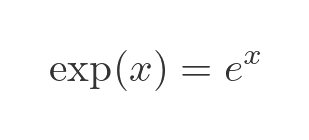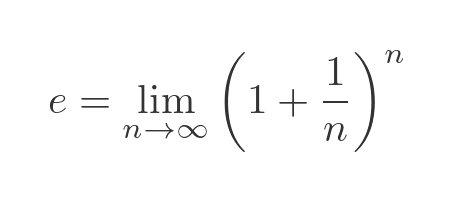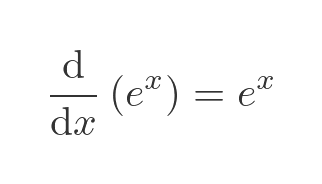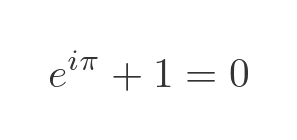What is e?
Categories: exponentials

You probably know of the mathematical quantity e. It is known as Euler's constant and is the base of natural logarithms. It is an irrational number, meaning that it cannot be represented exactly as a fraction, but instead has an infinite number of digits that never repeat. Its value is approximately 2.718281828459045.
The value e crops up quite a lot in mathematics, in ways that might appear to be unrelated. This article gives an overview of the various facets of e. Each section has a link to a more detailed article.
The exponential function
The value of e raised to the power x is an important function that is often used in mathematics. It is called the exponential function, sometimes written as exp(x):

Formula for the value of e
One of the standard equations for the value of e is this one:

This tells us that we can calculate an approximation to the value of e by calculating the formula with any chosen value of n. It also tells us that the larger the value of n we choose, the better the approximation will be. For example, if we choose a value of 2, the result will be 2.25, which isn't particularly close to the true value of e:

If we repeat the calculation with a value of 100, we get a slightly closer value of 2.704813829:

With a sufficiently large value of n, we can calculate e to as many decimal places as we wish (although, later on, we will see a better way to calculate e).
For more information, see Formula for e.
The exponential function is its own derivative
Next, we will look at one of the most important and useful properties of e, expressed in this equation:

This applies to the exponential function with a base equal to the special value e. It tells us that for any value x, the slope of the curve at that point is equal to the value of the curve at that point.
In fact, the exponential curve, with a base e, is the only function that has that property. (That isn't quite true, the function f(x) = 0 also has that property, because the value of the function and the slope of the function are both 0 everywhere, but that function isn't very interesting or useful).
This is an extremely useful property because there are many situations where the rate of change of a system is proportional to the value. Examples include radioactive decay, and population growth.
You might wonder why the exponential function has this property, and in particular, why it only happens when we choose this strange number e as the base.
For more information, see Derivative of the exponential function.
Maclaurin expansion of the exponential function
Next, we have this formula for calculating the exponential function as an infinite series:

Again, it seems very strange that a function of the irrational number e should have such a simple series. The reason this arises is that the terms in the Maclaurin expansion of a function are derived by repeated differentiation of the function. Since the exponential function has a very simple derivative, it is perhaps less surprising that its Maclaurin expansion should also be very simple.
For more information, see Maclaurin series of the exponential function.
Euler's identity
Finally, e is famously part of Euler's identity:

Before the discovery of this identity, it had generally been assumed that e, pi, and the imaginary unit i were unrelated constants that were applicable in different areas of mathematics - exponentials, geometry, and complex numbers. This formula links the three values in one simple formula.
This identity is derived from Euler's formula:

When θ is equal to π, the cosine term is -1 and the sine term is 0, which leads to Euler's identity:
For more information, see Euler's identity.
Related articles
Join the GraphicMaths Newsletter
Sign up using this form to receive an email when new content is added to the graphpicmaths or pythoninformer websites:

Popular tags
adder adjacency matrix alu and gate angle answers area argand diagram binary maths cardioid cartesian equation chain rule chord circle cofactor combinations complex modulus complex numbers complex polygon complex power complex root cosh cosine cosine rule countable cpu cube decagon demorgans law derivative determinant diagonal directrix dodecagon e eigenvalue eigenvector ellipse equilateral triangle erf function euclid euler eulers formula eulers identity exercises exponent exponential exterior angle first principles flip-flop focus gabriels horn galileo gamma function gaussian distribution gradient graph hendecagon heptagon heron hexagon hilbert horizontal hyperbola hyperbolic function hyperbolic functions infinity integration integration by parts integration by substitution interior angle inverse function inverse hyperbolic function inverse matrix irrational irrational number irregular polygon isomorphic graph isosceles trapezium isosceles triangle kite koch curve l system lhopitals rule limit line integral locus logarithm maclaurin series major axis matrix matrix algebra mean minor axis n choose r nand gate net newton raphson method nonagon nor gate normal normal distribution not gate octagon or gate parabola parallelogram parametric equation pentagon perimeter permutation matrix permutations pi pi function polar coordinates polynomial power probability probability distribution product rule proof pythagoras proof quadrilateral questions quotient rule radians radius rectangle regular polygon rhombus root sech segment set set-reset flip-flop simpsons rule sine sine rule sinh slope sloping lines solving equations solving triangles square square root squeeze theorem standard curves standard deviation star polygon statistics straight line graphs surface of revolution symmetry tangent tanh transformation transformations translation trapezium triangle turtle graphics uncountable variance vertical volume volume of revolution xnor gate xor gate
